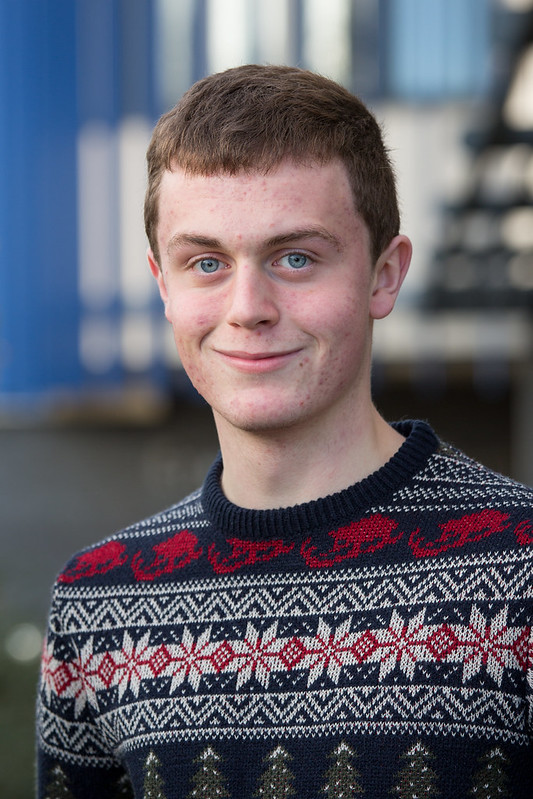As the weeks have gone by, our group of 10 students participating in the Thales Eureka Challenge have really started to work together as a coherent team, as well as being challenged to start thinking in new, exciting ways concerning design.
Armed with a range of new skills we've developed in recent weeks, we were all really itching to get our teeth into the live project. However, before this could happen, we had one last challenge.

As 16 – 18 year olds with little knowledge of working in a business environment, we were all rather excited to be told we would be embarking on a one night business trip up to a flagship Design Centre at Thales UKs Optronics facility in Glasgow. This was a real treat for all of us, as we've enjoyed our design activities up until now, but to be able to apply our newly acquired skills in an environment designed specifically for this purpose was going to be an exciting opportunity (not to mention, all expenses paid!).
Arriving in Glasgow on Wednesday evening, we were told to go off and enjoy ourselves for a few hours by exploring the delights of the city. As a team, we enjoyed each other's company in a lovely Italian restaurant (without running up the tab too much!), before heading out to examine what more the city had to offer. After a brief site seeing trip that principally revolved around a visit to the square where World War Z was filmed and many wrong turnings, we piled into bed ready for our early start the next day.
What no Zombies!!?
A Design Hotspot
Any building that was designed to look like a submarine is inevitably going to be full of some of the most cutting edge engineering we'd ever come across, and suffice to say we were all rather eager to get our teeth into the challenges of the day. Safe to say we weren't disappointed upon walking into the Design Centre itself. A clean, minimalist space, full of beanbags, large workstations, whiteboards and comfortable chairs is going to appeal to a bunch of not-quite-awake teenagers, and once suitably settled in, we could get down to business.
A Designer's Paradise
We had a simple challenge: three teams, each with one customer (Chris, Marie and Kelly all staff from the collage getting involved!) who all required a new wallet, which we were to design for them. This seemingly easy challenge was in fact not quite so, as we were to discover!
The first step was to get to know our customer, and what they wanted from a wallet. This stage is all about empathy. For our group (with Chris) this turned rather more into a therapy session. The key to design is to really understand your customer, in every way possible, and this required us to extract as much information about them and their lifestyle as was necessary. At this point we felt more like psychiatrists than engineers! However, this exhaustive approach was helpful in the long run, having such a deep understanding of our customers really helped us broaden our thinking.
Design Thinking in a Nutshell
Once we felt we knew our customers, we could actually work out what their actual design problem was. Hang on a minute, didn't I say it was to design a wallet? That's where design thinking gets complicated! In traditional engineering, a customer will come to you with a problem, and ask you to design for it. But with design thinking, it's all about finding what the real problem actually is.
In Chris' case, yes he needed a wallet, but we gained real insights into his life and worked out three main issues; keeping communicated, balancing work and family life and being secure with money. As such, we realised he did not necessarily need a traditional wallet, but a new way of storing/transporting money that would link into his communication needs and help keep a balance. This is known as 'reframing the problem'.
Teamwork in Action
With this design problem now re-framed, we could start to actually design. By this point, nearly half of the allotted time had passed, which to some people would seem strange, after all, weren't we on a Design Day? However, as established, to design properly, you need to know what you're designing for, and more importantly why? This is why the empathy and reframing stages are so important.
At this stage of the design process, we were already full to overflowing with ideas, and were ready to share! Brainstorming is of massive benefit here. All designs, no matter how wacky, could be explored, captured, moved around and merged with other ideas. Merged ideas (around 3) could be selected and expanded, with supporting details and pictures etc, and put to one side, or scrapped.
By the end of this brainstorming and merging session, we all had three ideas, with details, sketches and notes to present to our respective customers. A key point with design thinking is that a picture speaks a thousand words. Why describe a product to a customer, when you can show them a sketch? It's much easier to relate to a drawing, which improves the quality and richness of feedback from your customer.
At this point, a break was required. Getting our heads fully into the design world was pretty tiring (a late night may not have helped some!) so a free lunch was gratefully received. Thales were fantastic hosts, providing us with a wide spread of food, including Scotland's finest delicacy, Haggis – followed by a quick tour of the factory. To see such high tech engineering work happening was inspiring to us all, and we were all pleasantly surprised at just how clean the place was; no oily rags lying around here!
A man and his doughnut: happiness in a picture!
Feeling rather full up, and ready to get back into the design world, we now had to present our ideas to our customers. In many ways, this was the acid test, had our in depth ‘therapy’ sessions gone far enough? The answer was yes, gladly. Whilst none of our ideas were fully formed products yet, all of our three customers felt we'd got it spot on, coming up with plans that met their needs.
For Chris, we'd come up with an all-in-one phone case/app that removed the need for a wallet entirely, a 'value changing' banknote idea, so he could carry less around, and a security based wallet, with biometric locking and a homing beacon. As it happened, the value changing banknotes were a complete non-starter, as Chris could not see the point. He liked both of the other ideas, and actually asked if there was a method of combining them, something to look at, perhaps? These sessions demonstrated the value of engaging the customers and using the feedback to further refine our solutions.
Following on from our customer feedback, we refined our ideas into one cohesive plan, before we could start the final phase, prototyping! At this point, the design centre turned into something resembling the set of Art Attack, as cardboard, scissors, sellotape and Lego appeared to cover every surface.
All three groups fully modelled their products in role plays or small physical models, which enabled the customers to see the processes involved, and even get involved themselves! This really helped us get an understanding as to whether we had something good, and to gauge the customer reaction.
Lego, it's serious work okay!
And that was our design thinking crash course! Notice that at the end of the day, we still weren't at the stage of a completed product, far from it! With the prototypes we now had, in a real world situation we would go through the process again and again, refining and merging ideas, prototyping and developing until we had a product that was both feasible to build, satisfactory to the customer and commercially viable. We all had a fantastic day, the entire team getting stuck into the challenge (admittedly, a free lunch and doughnuts may have helped!) as well as getting a feel for real world design problems.




